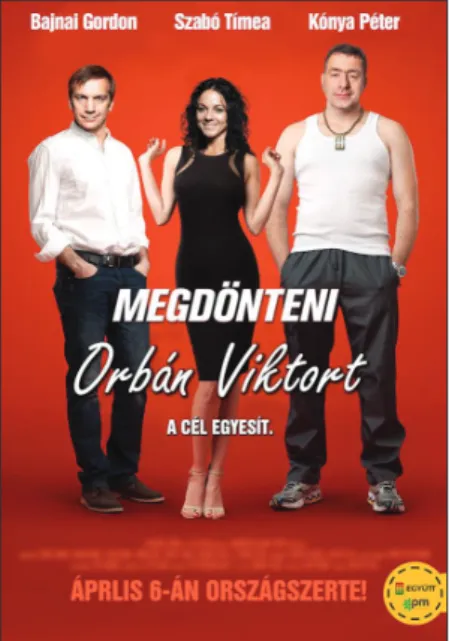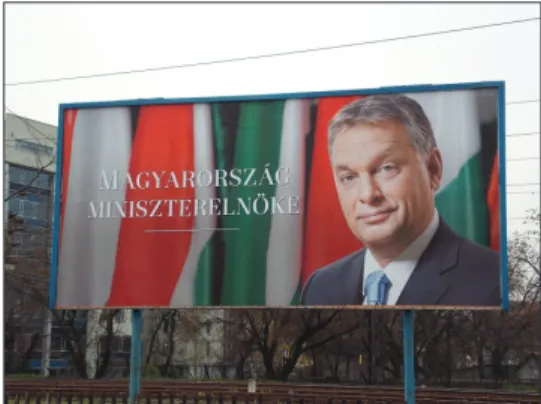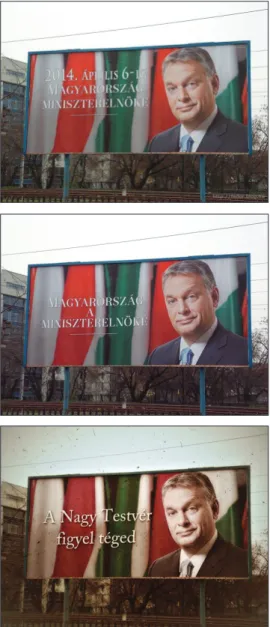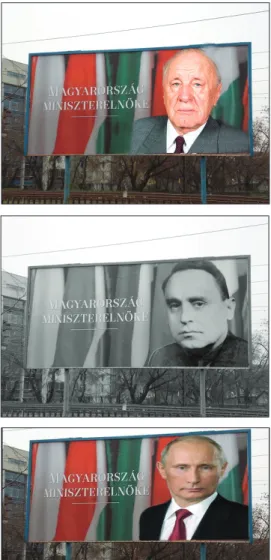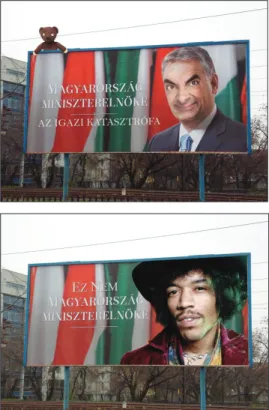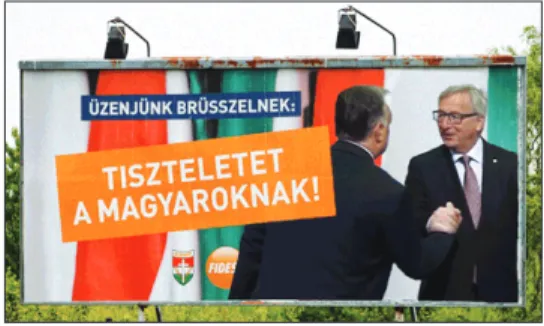CREATIVITY AND HUMOR IN THE ONLINE FOLKLORE OF THE 2014 ELECTIONS
IN HUNGARY
Katalin Vargha
Research Center for the Humanities Hungarian Academy of Sciences, Hungary e-mail: vargha.katalin@btk.mta.hu
Abstract: In the twenty-first century, digital media (including email, blogs, and social networks) plays an important role in political communication – both in the official communication of political campaigns and in the popular political humor of the elections. This paper focuses on the online, mainly humorous, folklore of the 2014 Hungarian elections. It demonstrates how, using traditional patterns of folklore as well as individual creativity, this material reflects the actual political situation.
Keywords: election campaigns, folklore, internet, memes, political humor
INTRODUCTION
Hungary held two elections in the spring of 2014: the parliamentary election on April 6, and the election of the Hungarian delegation to the European Parlia- ment on May 25. This paper will examine the mostly humorous online election folklore, which proved highly variable and popular among internet users during the campaign period preceding these two elections. This topic was chosen as a case study on online folklore or internet folklore for multiple reasons:
(1) Political elections, especially their preceding campaigns, inspire vernacu- lar reactions that include vast amounts of folkloric texts, most of which fit into specific genres such as election rhymes, recruitment songs, anecdotes, jokes, etc.
(2) The technological advances of the twenty-first century allow election folklore to be distributed face-to-face and increasingly via electronically mediated communication (SMS, MMS, email, forum discussions, blogs, social media, etc.). However, just as election folklore has found its way to computer- mediated communication in the last few decades, the online environment has at the same time inspired new folkloristic forms such as the internet meme.
(3) As political elections (and their results) impact all Hungarian citizens, the potential exists for all Hungarian citizens to become involved as produc- ers, consumers, and/or distributors of online election folklore as a form of political participation. Thus, the collection of relevant data on contemporary folklore simultaneously provides data on the folklore process: the creation, reception, transmission, and variation of this material across the internet.
(4) Although serious research on digital folklore is rare and of rather vary- ing quality in Hungary to date, the topic of popular political communication and folklore in a digital environment has received considerable attention and provides the background for this research.
This paper will outline the theoretical framework with basic concepts of online election folklore. It will draw attention to research conclusions on the online folklore of the 2002, 2006, and 2010 elections. And finally, it will present the findings on the 2014 online election folklore as illustrated by a representative sequence of campaign poster parodies.
THEORETICAL FRAMEWORK AND BASIC CONCEPTS
The study of online election folklore fits into the ever-changing concept of folklore as it draws on the traditional genres and texts of folklore (jokes, recruitment songs, and other short forms). Furthermore, key concepts of folklore studies, such as variation and adaptation, can be used to describe and interpret the new phenomena summed up under the umbrella term internet memes. Although examples themselves may be considered ephemeral, and even incomprehensible and irrelevant without contextual information, certain textual elements, motifs, formulas, plots, as well as visual patterns, etc., emerge again and again, serving as components in a line of tradition (cf. Blank & Howard 2013).
Most internet folklore and humor is topical, addressing current issues and events of either local or global interest (Laineste 2002; Blank 2013). This in- tertwines with the concept of newslore, a term coined by Russell Frank (2004, 2011) to describe “folklore that comments on, and is therefore indecipherable without knowledge of, current events” (Frank 2011: 7). Newslore takes multiple forms including “jokes; urban legends; digitally altered photographs; mock news stories; …; parodies of songs, poems, political and commercial advertisements, and movie previews and posters” (Frank 2011: 7). Election folklore fits perfectly into the concept of newslore; it is formulated topically, integrates popular reac- tions to the events and issues of the political campaign preceding the elections, and refers to the parties and individuals involved in it.
Most examples of online election folklore are humorous and can thereby be interpreted in the framework of political humor. According to the new Encyclo- pedia of Humor Studies, political humor is an umbrella term in which “[p]olitics refers broadly to social behaviors related to the governing bodies of a nation or comparable entity. Political humor, then, encompasses humor directed at or derived from politics, policies, political parties, institutions, and individuals involved in the political process, as well as humor used by politicians themselves”
(Bippus 2014: 585). Tsakona and Popa stress building on the interplay of text and context, saying that “political humour usually does not inform the audi- ence on political issues, but explicitly comments on them, and conveys critical stance towards certain political acts and figures” (Tsakona & Popa 2011: 8–9).
In the case of election humor, the most important contextual element is the official political campaign itself, including the participating parties, their can- didates, the campaign events and messages, and the various issues that occur throughout the campaign period (scandals, corruption, inappropriate behavior of politicians, etc.).
RESEARCH METHODS AND BACKGROUND
Due to the rapid developments within the online community, both in terms of technology and content, which impacts user interaction, the research methods used in this study could be considered somewhat experimental.1 The first re- search phase consisted of a detailed examination of the existing studies on the digital election folklore of the Hungarian parliamentary elections of 2002, 2006, and 2010. The second research phase consisted of collecting live online folklore during the 2014 election campaigns beginning in February 2014 through to the European Parliament elections on May 25. This phase involved gathering online folklore, monitoring relevant sites (blogs, tweets, commentary, etc.), and closely following online reactions to specific events, slogans, and other campaign texts (on methodology see Radchenko 2013; Domokos 2014).
Previous research and findings on digital election folklore in Hungary between 2002 and 2010
Hungarian scholars of communication, media studies, and political science consider 2002 a turning point in the use of online communication during elec- tions, as well as its study. In 2002, “informational technologies as postmod- ern campaign tools” were introduced to Hungarian political campaigns as an
innovation (Dányi 2002: 23). This, however, meant primarily one-way content supply: messages being sent from the parties or politicians to voters. At the same time, following the first round of parliamentary elections, electronic com- munication took on a different role. Activists and supporters of the governing party, struck by the unexpected results that eventually led to the victory of the left-wing opposition, made a desperate attempt to regain their position by sending a large number of official campaign messages and related folkloristic content via SMS and email.2
An online archive was immediately set up by the Open Society Archives (OSA) at Central European University, Budapest, collecting “… electronic cam- paign mail, [and] inviting all recipients of email and cell phone text messages related to the parliamentary elections to forward them to designated accounts.
A large number of people responded by forwarding messages supporting, criti- cizing, accusing, or parodying the parties and candidates standing for election”
(Székely 2008: 308; see also http://www.osaarchivum.org/hu/projects).
The incoming messages recorded from April 10 to May 10, 2002, and the online archive containing 900 emails and 185 SMSs is, to date, accessible in Hungarian,3 with a selection of texts translated into English.4 A sizeable group of texts included humorous political rhymes, up-to-date political adaptations, and parodies of classic poems (Sükösd & Dányi 2002: 289–290). This “election folklore” was studied by folklorists who attempted to outline their main genres:
jokes, proverbs, paraphrases, prophecy parodies, rumors and rumor parodies, catchwords, and election rhymes (Balázs 2004; Nagy 2005; Povedák 2014). One scholar stressed that these texts are “folklore creations in the strictest sense of the word in contrast to mass culture since they are both expressions of a com- munity with the power to form a community” (Povedák 2014: 167), and further argued that they express an independent and contemporary folk culture.
Researchers expected that the formation of digital election folklore as a popu- lar reaction to the election campaign was in line with technological progress, and were prepared to archive and study it in subsequent elections, but the material collected in 2006 and 2010 was significantly scantier and excited less research interest (Povedák 2014: 167). These materials also became significantly more visual (cf. Baran 2012).
In 2006, the OSA Archivum “reopened its archive of electronic campaign letters, again inviting recipients of electronic messages related to the new par- liamentary elections to forward these messages”.5 However, the number of messages forwarded to the OSA decreased significantly as compared to 2002.
The SMS as a medium virtually disappeared as visual emails (with pictures at- tached or embedded) came to replace text messages. The quality of these digitally modified pictures improved significantly, in some cases reaching a professional
level (Székely 2008: 313).6 Most of them were modified versions of official cam- paign posters, some conveying political messages, others just making fun of them (Bodoky 2006).7
In 2010, online political communication was significantly present in the cam- paigns of political parties, and included the use of personal blogs and YouTube videos, but social media and microblogging (e.g. Twitter) were not yet effectively used (Burján 2010a, 2010b). The OSA did not resume the collection and study of campaign messages. Digitally modified, mock election posters were collected on a communal blog called “Vote-o-shop: retouched campaign 2010”8, wherein technical support was also offered to those intending to contribute, making it a kind of participatory archive.
ONLINE FOLKLORE OF THE 2014 PARLIAMENTARY ELECTIONS IN HUNGARY
The expansion of internet services and mobile internet in the few years lead- ing up to the 2014 election9 inevitably played an important role in the more intensive online presence and activity of political parties and individual poli- ticians on various platforms of online media. The first part of the ‘fieldwork’
for this study involved monitoring three of the most widely read Hungarian news portals (index.hu, origo.hu, hvg.hu), their blogs and social media sites throughout the research period to gain an overall impression of the campaign, main figures, events, issues, etc., and to track vernacular responses and vari- ous forms of online election folklore. We also monitored the official Facebook pages of the incumbent prime minister, Viktor Orbán, and the contending prime minister candidates (Attila Mesterházy, Gábor Vona, Gordon Bajnai), as well as the political parties or groups of supporters involved in their campaigns.
The second, more intensive part of the research included selecting significantly popular or variable text and meme types, and determining which political is- sues were the main sources of internet humor in connection with the campaign.
These materials include examples of traditional folklore genres (e.g. jokes and humorous modifications of folk songs),10 but contemporary, online election folk- lore operates predominantly with new genres or forms summed up under the heading “internet memes”. This category, used both by researchers and online
“prosumers”, sums up “images, videos, audios, and hyperlinks with humorous content, which are created by individuals with online access and easy-to-use software”, which are “often employed as a form of political and social participa- tion” (Shifman 2014: 392).11
Here, we focus on one type of internet meme: digitally modified images or image macros (Rutkoff 2007). In this research these are mostly modifications of campaign posters that contradict the statements, messages and achievements of the official campaign, producing incongruity by changing the picture, the text, or both, and thus being humorous. But such modifications are not always
“folkloristic”. Official campaign posters can also mock the opponents, expressing criticism of their statements or actions. In this case they have a direct political goal of influencing voters, primarily by casting their opponents in a negative light. The situation is further complicated in the case of poster parodies cre- ated by supporters of a political party that later become incorporated in official or semi-official political communication, for example, when such posters are distributed on the official Facebook page of a political party. The following modification of a film poster provides an example of the merger of official and vernacular political communication.
The original poster for the film released in Hungarian cinemas on Feb- ruary 13, 2014 (Fig. 1), advertises a romantic comedy whose title alludes to sexuality “To Knock Down Tímea Hajnal”. The creator of the parody poster (Fig. 2), a supporter of the liberal coalition Együtt-PM, modified a number of the original poster’s textual and visual details. In the parody poster, the
Figure 1. Source: http://filmbook.
blog.hu/2014/02/10/megdonteni_
hajnal_timeat_671/, last accessed on 25 September 2018.
F i g u r e 2 . S o u r c e : h t t p : / / 4 4 4 . hu/2014/02/14/az-ellenzek-elveszitette- az-eszet, last accessed on 25 September 2018.
title and the proverbial slogan (“The goal sanctifies the means”) was changed to a political message: “To knock down Viktor Orbán. The goal unites”. The poster substitutes the faces and names of leading actors with those of leading liberal candidates. Furthermore, the film’s release date was changed to that of the parliamentary elections. The parody poster’s image soon appeared on the official Facebook page of the political party, Együtt 2014 (Together 2014), and was used as an unofficial campaign poster.
A noticeable feature of the gathered 2014 campaign folklore as well as the official campaign was personalization. As István Povedák states:
Contemporary political style is increasingly dominated by tabloidization and personalization. This includes a focus on the leader [i.e. political leader], which is characterized not only by the fact that political messages shift rather from organizations to individuals, but also by popularization, that is the representation of political events through the lives of ordinary people. (Povedák 2014: 153)
One example that has inevitably influenced the strategies of Hungarian parties is the 2008 online campaign of Barack Obama, which utilized online tools (social media, paid bloggers, email communication, and YouTube videos) to effectively convey his message, and his 2012 campaign which mobilized activists of online networks (Merkovity 2009; Takaragawa & Carty 2012; Hong & Nadler 2012; on the folkloristic aspects of the US election campaign see Duffy & Teruggi Page
& Young 2012; on the ‘LOLitics’ of the 2012 election see Tay 2014).
During the 2014 Hungarian election campaigns, the most popular target of election humor was undoubtedly Viktor Orbán, who, as head of Fidesz, the governing party, served as Hungary’s prime minister from 1998 to 2002, and again from 2010 to the present. Because of his political role, his leadership style, and his personality, a considerably rich folklore has developed around him throughout the past seventeen years (see Povedák 2011: 159–175; for a detailed analysis of Viktor Orbán as a hero of contemporary folklore see Povedák 2014).
Opinion polls have shown that Viktor Orbán’s popularity significantly exceeds the popularity of his political party, hence the Fidesz campaign in 2014 was based personally on the prime minister.
The personalization and tabloidization accompanying the campaign period can be illustrated by the example of the pink couch. The original image (Fig. 3) comes from a photoshoot for a tabloid magazine in which Viktor Orbán and his family participated. It was originally published on the official Facebook page of the prime minister, and led to numerous parodies referencing popular culture: the couch and Orbán depicted jointly as a product in an IKEA cata- logue (Fig. 4); the couch inserted in a frame of the American television show,
Friends, with members of the governing party, Fidesz, taking on the main roles (Fig. 5). Another poster parody conveyed a direct political message in support of the left-wing party, MSZP, by placing politicians and other commonly known personalities linked to the Fidesz campaign, who had been involved in contro- versial issues or scandals during the campaign period, on the couch (Fig. 6).
Figure 3. Source: http://hvg.hu/
itthon/20140331_Foto_Orban_Viktor_
tudja_fokozni, last accessed on 25 September 2018.
F i g u r e 4 . S o u r c e : h t t p : / / h v g . h u / velemeny/20140331_Fotok_Orban_Putyin_
vallan_pihen_avagy_bei, last accessed on 25 September 2018.
Figure 6. Source: http://hvg.hu/
velemeny/20140402_Fotok_Rogan_
basa_Cili_es_a_Baratok_kozt_, last accessed on 25 September 2018.
Figure 5. Source: http://www.
n y u g a t . h u / t a r t a l o m / c i k k / orbaneknal_mar_rozsaszin_az_elet_
egy_kanapeban, last accessed on 25 September 2018.
The Prime Minister of Hungary
The last part of this paper focuses on one sequence of variants as a repre- sentative example of the online folklore of the 2014 elections in Hungary. The numerous variants were based on a campaign poster for the incumbent prime ministerial candidate, Victor Orbán, of the governing party, Fidesz (Fig. 7).
Figure 7. Source: http://hvg.hu/velemeny/20140317_
Mem_orban_plakat, last accessed on 25 September 2018.
The poster consists of three main elements: a portrait of Viktor Orbán, a simple text in white, saying “The prime minister of Hungary”, and Hungarian national flags in the background. Although this was the main campaign poster for Fidesz, it did not contain any concrete reference to the political party, the person in the picture or the election at all. The simple poster with a very simple message provided a blank canvas on which ‘online folk artists’ could create a vast num- ber of variations by changing one or more of the three elements listed above.
One group of these poster parodies changed only the text to contradict the original message by adding the date of the elections “Prime minister of Hun- gary – until the 6th of April” (Fig. 8). Other modifications used wordplay or puns to considerably modify the meaning with only minor changes in the wording.
Adding a definite article and changing a single letter in one word changes “Ma- gyarország miniszterelnöke” (Prime Minister of Hungary) into “Magyarország a miniszterelnöké” (Hungary is the property of the Prime Minister), an ironic reference to the centralization accomplished by the government between 2010 and 2014 (Fig. 9). The last example of this type of poster adaptation shows the original text has been changed to the quote, “Big Brother is watching you” from George Orwell’s novel 1984 (Fig. 10).
Another group of examples uses only visual modifications, changing the por- trait and/or the background, to achieve incongruity. Several of these examples refer to Viktor Orbán’s leadership style by substituting his portrait with those of Hungarian political leaders from the totalitarian regime, e.g. János Kádár (Fig. 11) and Ferenc Szálasi (Fig. 12), as well as the current Russian president Vladimir Putin (Fig. 13).
Figure 8. Source: https://www.facebook.
com/photo.php?fbid=573626526077714&s et=a.164881300285574.35644.1147354653 00158&type=1&theater, no longer available.
Figure 9. Source: http://szarvas.tumblr.
com/image/79814367340, last accessed on 25 September 2018.
Figure 10. Source: http://galeria.
index.hu/tech/2014/03/17/orban_a_
fonok_a_memeskutban/4, last accessed on 25 September 2018.
By modifying both the textual and visual content, parodies can convey a more complex message or more specific reference to current events. But they can also shift the context from direct political content to other phenomena of popular culture, with (often nonsensical) humor (cf. Bodoky 2006: 31). One poster shows Mr. Bean in Orbán’s place, with the text “The prime minister of Hungary. The ultimate disaster” (Fig. 14). The creator of the poster parody refers to a popular comedian of that time, and also expresses his political views. Another poster replaces Orbán’s portrait with that of Jimi Hendrix, with text stating that
“This is not the prime minister of Hungary” (Fig. 15) – a message as simple as the original.
Figure 11. Source: http://fideszfigyelo.
blog.hu/2014/03/16/vegre_kiderult_hogy_
mi_a_fidesz_programja, last accessed on 25 September 2018.
Figure 12. Source: http://galeria.
index.hu/tech/2014/03/17/orban_a_
fonok_a_memeskutban/3, last accessed on 25 September 2018.
Figure 13. Source: http://csattogoslepke.
tumblr.com/post/79807609381, no longer available.
Following their success in the parliamentary election, Fidesz repurposed the posters (shown in Fig. 7) for the European Parliament campaign by pasting a new text over the old one: “Let’s tell Brussels: Respect the Hungarians!”, and adding the logos of Fidesz and KDNP (Fig. 16).
Figure 14. Source: http://cink.hu/
magyarorszag-miniszterelnoke-2-1545105733, last accessed on 25 September 2018.
Figure 15. Source: http://pauszkoepkoedoe.
tumblr.com/post/79804142656/tegyuk- tisztaba-a-gyereket, no longer available.
Figure 16. Source: http://www.nyugat.hu/tartalom/cikk/eu_indian_
bajnai_gyikmosolyu_orban, last accessed on 25 September 2018.
The renewed posters inspired a new, even stronger wave of modifications, traces of which can still be observed today. The message (and sometimes the addressee) was changed in many ways, for example, suggesting telling Brussels (and thus the European Union) to “[s]end more money”.12 The poster became an internet meme, stimulating official and popular, political and non-political responses.
Even after the elections a meme generator was set up for a few months to allow the user to change the message and addressee of the original poster by filling in two text-boxes. These poster modifications could be distributed with a link to the generator.13 The slogan “Respect the Hungarians” became proverbial, inspiring paraphrases, wordplay, and jokes.
More recent political events underline that a year later, the poster and slogan, “Respect the Hungarians”, are still known and can serve as a point of reference available for further variation. On May 22, 2015, Jean-Claude Juncker, president of the European Commission and former prime minister of Luxembourg, called Hungary’s prime minister a dictator and playfully slapped him in the face during a press photoshoot at the Riga Summit.14 A vernacular reaction – in the form of an animGIF – was born within 24 hours (Fig. 17).
Together with the inserted video, the original message – asking for more respect from the European Union – gained an entirely new meaning.
Figure 17. Source: http://sailorripley.tumblr.com/post/119630799351/
most-mar-tenyleg-hadat-kellene-uzenni-az-unionak, last accessed on 25 September 2018.
CONCLUSIONS
This paper presented a case study on contemporary folklore in an electronic environment, examining material that was created during the campaign period preceding the 2014 elections in Hungary. Most of the collected ‘online elec- tion folklore’ cannot be placed in any of the traditional folklore genres, but is rather a popular reaction to the campaign in a visual form, most often an image macro. Although examples themselves may be considered ephemeral, and even incomprehensible and irrelevant without contextual information, certain textual elements, motifs, formulas, plots, as well as visual patterns, etc. emerge over and over again, serving as components in a line of tradition.
NOTES
1 This paper is based on research conducted together with my colleague, Mariann Domo- kos. A longer research paper addressing the theoretical and methodological questions of studying online folklore has been published in Hungarian (Domokos & Vargha 2015).
2 For example: “Viktor Orbán writes: We need more for the fight. / When next we hear the call, / In line we all must fall! / Long live our homeland! / Pass it on to five patriots”
(Povedák 2014: 167). This text is based on the Kossuth song, a folk song over 150 years old, with more than 600 variants known from oral distribution. On its use and innovative variants referring to daily politics see Domokos & Vargha 2015: 151–154.
3 See http://kampanyarchivum.osaarchivum.org/kampany02/list.php, last accessed on 16 October 2018.
4 See http://kampanyarchivum.osaarchivum.org/eng.html, last accessed on 16 October 2018.
5 See http://www.osaarchivum.org/hu/projects, last accessed on 15 October 2018.
6 The 2006 messages are available on the following website: http://kampanyarchivum.
osaarchivum.org/kampany06/list.php, last accessed on 16 October 2018.
7 Tamás Bodoky, researcher of media studies, analyzed 567 campaign poster parodies archived from the sg.hu forum titled “We Photoshop worse than four years ago”, alluding to the Fidesz campaign slogan: “We live worse than four years ago” (Bodoky 2006). The forum itself is no longer available.
8 See http://voteoshop.blog.hu/, last accessed on 25 September 2018. Administrators of the blog identified it as a resumption of the 2006 forum “We Photoshop worse than four years ago”, containing “honest and/or funny versions of campaign posters, films and other political advertisements”.
9 In Hungary, with a population of nearly 10 million people, the number of internet subscriptions was roughly 2.8 million at the end of 2009 (see https://www.ksh.hu/docs/
eng/xstadat/xstadat_annual/i_oni001.html, last accessed on 25 September 2018). By the end of the first quarter of 2014, the number of subscriptions exceeded 6.6 million;
the most dynamically expanding area is mobile internet with over 4 million subscrip- tions (see https://www.ksh.hu/docs/hun/xstadat/xstadat_evkozi/e_oni001.html, last accessed on 25 September 2018). Detailed data can be found on the website of the Hungarian Central Statistical Office (see http://www.ksh.hu/?lang=en, last accessed on 25 September 2018).
10 Although the most traditional, and, for over a century, the most common and popular genre of political humor is the political joke used extensively to comment on political issues, political figures and parties, we came across very few political jokes regarding the 2014 election in our online research.
11 Merrill Kaplan gives the following definition of the meme as a genre: “On the Internet, meme has become a genre term, albeit a broad one. Meme may refer to nearly any creation or practice that has ‘gone viral’, in which it is transmitted, transformed, and re- transmitted quickly and widely enough across the Internet and other new media outlets to have attained status as a familiar cultural reference online. Examples may include catchphrases, edited photographs, image macros, and pranks” (Kaplan 2013: 136).
12 See http://pontosan-ahogy.tumblr.com/post/84523048470/az-eredeti-se-rossz-magyarisztan- tumblr-com, last accessed on 25 September 2018.
13 See http://hvg.hu/tudomany/20140527_uzenjen_on_is_itt_a_fidesz_generator, last accessed on 25 September 2018.
14 See http://www.bbj.hu/politics/juncker-calls-orban-dictator-slaps-him_98018; video available at http://coub.com/view/6jhry, both last accessed on 25 September 2018.
REFERENCES
Balázs, Géza 2004. Választási sms-ek folklorisztikai-szövegtani vizsgálata. [Folkloristic- Textological Study of Campaign SMSs.] Magyar Nyelvőr, Vol. 128, No. 1, pp. 36–
53. Available at http://www.c3.hu/~nyelvor/period/1281/128104.pdf, last accessed on 25 September 2018.
Baran, Anneli 2012. Visual Humour on the Internet. In: Liisi Laineste & Dorota Brzo- zowska & Władisław Chłopicki (eds.) Estonia and Poland: Creativity and Tradi- tion in Cultural Communication. Vol. 1. Jokes and Their Relations. Tartu: ELM Scholarly Press, pp. 171–186. DOI: 10.7592/EP.1.baran.
Bippus, Amy M. 2014. Political Humor. In: S. Attardo (ed.) Encyclopedia of Humor Studies.
Los Angeles: SAGE, II, pp. 585–588. http://dx.doi.org/10.4135/9781483346175.
n259.
Blank, Trevor J. 2013. The Last Laugh: Folk Humor, Celebrity Culture, and Mass- Mediated Disasters in the Digital Age. Madison: University of Wisconsin Press.
Blank, Trevor J. & Howard, Robert Glenn (eds.) 2013. Tradition in the Twenty-First Century: Locating the Role of the Past in the Present. Logan, Utah: Utah State University Press.
Bodoky, Tamás 2006. Többet retusálunk, mint négy éve. Választási kampányplakátok az interneten. [We Rethink More Than Four Years Ago: Election Campaign Post- ers on the Internet.] Médiakutató, Vol. 7, No. 2, pp. 7–31. Available at http://
www.mediakutato.hu/cikk/2006_02_nyar/01_tobbet_retusalunk, last accessed on 25 September 2018.
Burján, András 2010a. Internetes politikai kampány. [Political Campaign on the Internet.] Médiakutató, Vol. 11, No. 3, pp. 93–103. Available at http://www.
mediakutato.hu/cikk/2010_03_osz/08_internet_kampany/?q=kampány#kampány, last accessed on 25 September 2018.
Burján, András 2010b. Internetes politikai kampány 2. [Political Campaign on the Internet 2.] Médiakutató, Vol. 11, No. 4, pp. 37–50. Available at http://www.mediakutato.
hu/cikk/2010_04_tel/03_internet_politika_kampany/?q=kampány#kampány, last accessed on 25 September 2018.
Dányi, Endre 2002. A faliújság visszaszól. Politikai kommunikáció és kampány az interneten. [Political Communication and Campaign on the Internet.] Médiakutató, No. 7, pp. 23–36. Available at http://www.mediakutato.hu/cikk/2002_02_nyar/02_
faliujsag_visszaszol/?q=kampány#kampány, last accessed on 25 September 2018.
Domokos, Mariann 2014. Towards Methodological Issues in Electronic Folklore. Slovenský Národopis, Vol. 62, No. 2, pp. 283–295. Available at http://www.uet.sav.sk/files/
etno2-text-web-27-6.pdf, last accessed on 25 September 2018.
Domokos, Mariann & Vargha, Katalin 2015. Elektronikus választási folklór 2014. [Digital Folklore of Political Elections in Hungary 2014.] Replika, No. 90–91, pp. 141–169.
Available at http://www.replika.hu/system/files/archivum/90-91_09_domokos_var- gha.pdf, last accessed on 25 September 2018.
Duffy, Margaret & Teruggi Page, Janis & Young, Rachel 2012. Obama As Anti-American:
Visual Folklore in Right-Wing Forwarded E-mails and Construction of Conserva- tive Social Identity. Journal of American Folklore, Vol. 125, No. 496, pp. 177–203.
http://dx.doi.org/10.5406/jamerfolk.125.496.0177.
Frank, Russell 2004. When the Going Gets Tough, the Tough Go Photoshopping:
September 11 and the Newslore of Vengeance and Victimization. New Media
& Society, Vol. 6, No. 5, pp. 633–658. http://dx.doi.org/10.1177/146144804047084.
Frank, Russell 2011. Newslore: Contemporary Folklore on the Internet. Jackson: Uni- versity Press of Mississippi.
Hong, Sounman & Nadler, Daniel 2012. Which Candidates Do the Public Discuss Online in an Election Campaign? The Use of Social Media by 2012 Presidential Candidates and Its Impact on Candidate Salience. Government Information Quarterly, Vol. 29, No. 4, pp. 455–461. Available at https://www.sciencedirect.com/journal/government- information-quarterly/vol/29/issue/4, last accessed on 25 September 2018.
Kaplan, Merrill 2013. Curation and Tradition on Web 2.0. In: Trevor J. Blank & Robert Glenn Howard (eds.) Tradition in the Twenty-First Century: Locating the Role of the Past in the Present. Logan, Utah: Utah State University Press, pp. 123–148.
Available at http://muse.jhu.edu/book/23562, last accessed on 25 September 2018.
Laineste, Liisi 2002. Take It with a Grain of Salt: The Kernel of Truth in Topical Jokes. Folklore: Electronic Journal of Folklore, Vol. 21, pp. 7–25. http://dx.doi.
org/10.7592/FEJF2002.21.jokes.
Merkovity, Norbert 2009. Barack Obama elnöki kampányának sajátosságai.
[Particularities of the Presidential Campaign of Barack Obama.] Médiakutató, Vol. 10, No. 1, pp. 97–106. Available at http://epa.oszk.hu/03000/03056/00034/
EPA03056_mediakutato_2009_tavasz_08.html, last accessed on 25 September 2018.
Nagy, Ilona 2005. Folklór „in statu nascendi”: Magyar választások 2002-ben. [Folklore
“in statu nascendi”: Hungarian Elections in 2002.] In: István Csörsz Rumen (ed.) Mindenes gyűjtemény I. Tanulmányok Küllős Imola 60. születésnapjára.
Artes Populares 21. Budapest: ELTE BTK Folklore Tanszék, pp. 465–471.
Available at http://real.mtak.hu/25578/1/ArtesPopulares_21.pdf, last accessed on 25 September 2018.
Povedák, István 2011. Álhősök, hamis istenek? Hős- és sztárkultusz a posztmodern kor- ban. [Pseudo-Heroes, False Gods: Hero and Star Cult in the Postmodern Age.]
Szeged: Gerhardus. Available at http://www.academia.edu/7270209/, last accessed on 25 September 2018.
Povedák, István 2014. One from Us, One for Us: Viktor Orbán in Vernacular Culture.
In: István Povedák (ed.) Heroes and Celebrities in Central and Eastern Europe.
Szeged: Department of Ethnology and Cultural Anthropology, pp. 153–171. Avail- able at http://www.academia.edu/7204198/, last accessed on 25 September 2018.
Radchenko, Daria 2013. “Ishchite nas cherez Iandeks”: metodiki i problemy sbora setevogo fol’klora. [“Search for Us through Yandex”: Methodology and Problems of Collecting Online Folklore.] Tautosakos darbai / Folklore Studies, Vol. 45, pp. 116–131. Available at http://www.llti.lt/failai/10_Radcenko(1).pdf, last accessed on 25 September 2018.
Rutkoff, Aaron 2007. With ‘LOLcats’ Internet Fad, Anyone Can Get In on the Joke.
The Wall Street Journal, August 25. Available at https://www.wsj.com/articles/
SB118798557326508182, last accessed on 25 September 2018.
Shifman, Limor 2014. Internet Humor. In: S. Attardo (ed.) Encyclopedia of Humor Studies.
Los Angeles: SAGE, I, pp. 389–393. http://dx.doi.org/10.4135/9781483346175.
n180.
Sükösd, Miklós & Dányi, Endre 2002. M-politika akcióban. SMS és e-mail a 2002-es magyarországi választási kampányban. [SMS and E-mail in the 2002 Hungarian Election Campaign.] In: Nyíri Kristóf (ed.) Mobilközösség – mobilmegismerés.
Budapest: MTA Filozófiai Kutatóintézete, pp. 273–293. Available at http://www.
mta.t-mobile.mpt.bme.hu/dok/3_suk-dany.pdf, last accessed on 26 September 2018.
Székely, Iván 2008. Elektronikus kampánylevél-archívum: A hálózatelemzés lehetőségei.
[Archives of Electronic Campaign Letters: Possibilities of Network Analysis.] In:
Jolán Róka (ed.) Academia Budapestiensis Communicationis et Negotii: Annales, Tomus I. pp. 307–316. Budapesti Kommunikációs és Üzleti Főiskola. Available at https://anzdoc.com/elektronikus-kampanylevel-archivum-a-halozatelemzes- lehetseg.html, last accessed on 26 September 2018.
Takaragawa, Stephanie & Carty, Victoria 2012. The 2008 U.S. Presidential Election and New Digital Technologies: Political Campaigns as Social Movements and the Significance of Collective Identity. Tamara: Journal for Critical Organiza- tion Inquiry, Vol. 10, No. 4, pp. 73–89. Available at https://tamarajournal.com/
index.php/tamara/article/view/114/pdf_7, last accessed on 26 September 2018.
Tay, Geniesa 2014. Binders Full of LOLitics: Political Humour, Internet Memes, and Play in the 2012 US Presidential Election (and Beyond). European Journal of Humour Research, Vol. 2, No. 4, pp. 46–73. http://dx.doi.org/10.7592/EJHR2014.2.4.tay.
Tsakona, Villy & Popa, Diana E. 2011. Humour in Politics and the Politics of Humour:
An Introduction. In: Villy Tsakona & Diana E. Popa (eds.) Studies in Political Humour. Amsterdam & Philadelphia: John Benjamins, pp. 1–30.
